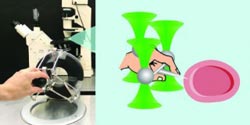To Touch the Microcosmos

Pacore/UPMC<br><br>Conceptual representation of a highly nimble micromanipulation experimental setup. Cells can be explored with advanced laser trapped microtools that extend the operator's sense of touch thanks to a specifically designed haptic teleoperated optical tweezers.<br>
What if you could reach through a microscope to touch and feel the microscopic structures under the lens? In a breakthrough that may usher in a new era in the exploration of the worlds that are a million times smaller than human beings, researchers at Université Pierre et Marie Curie in France have unveiled a new technique that allows microscope users to manipulate samples using a technology known as “haptic optical tweezers.”
Featured in the journal Review of Scientific Instruments, which is produced by AIP Publishing, the new technique allows users to explore the microworld by sensing and exerting piconewton-scale forces with trapped microspheres with the haptic optical tweezers, allowing improved dexterity of micromanipulation and micro-assembly.
“The initial results obtained are promising and demonstrate that optical tweezers have a significant potential for haptic exploration of the microworld,” said Cecile Pacoret, a co-author of the study. “Haptic optical tweezers will become an invaluable tool for force feedback micromanipulation of biological samples and nano- and microassembly parts.”
One of the challenges in developing this technique was to sense and magnify piconewton-scale forces enough to enable human operators to perceive interactions that they have never experienced before, such as adhesion phenomena, extremely low inertia, and high frequency dynamics of extremely small objects, like the Brownian motion. The design of optical tweezers for high quality touch-based feedback is challenging, given the requirements for very high sensitivity and dynamic stability.
This research required a mix of different experimental techniques and theoretical knowledge. Labs at the Institut des Systèmes Intelligents et de Robotique possessed expertise in both microrobotics and in haptics which were needed but the research team, as the project progressed, realized that they needed additional expertise in optics and vision, which was available at the university. “This project would not have been possible without this multidisciplinary environment and additional collaboration of the international optical tweezers community,” states Dr. Pacoret. “The high level of interdisciplinary cooperation is what made this project unique, and contributed to its success.”
The ability to use touch as a tool to allow exploration, diagnosis and assembly of widespread types of elements from sensors, microsystems to biomedical elements, including cells, bacteria, viruses, and proteins is a real advance for laboratories. These objects are fragile, and their dimensions make them difficult to see under microscope. If this tool can restore the sense of touch under microscopic operation, it will help not only efficiency but also expand scientific creativity, said Dr. Pacoret, adding that she and her team are excited about the possibilities.
“This tool will offer a new degree of freedom and accessibility to researchers, providing, for example, new versatility for the study and micromanipulation of cells,” she said.
The article, “A review of haptic optical tweezers for an interactive microworld exploration” by Cécile Pacoret and Stéphane Régnier appears in the journal Review of Scientific Instruments. See: http://dx.doi.org/10.1063/1.4818912
ABOUT THE JOURNAL
Review of Scientific Instruments publishes original research and review articles on instruments in physics, chemistry, and the life sciences. The journal also includes sections on new instruments and new materials. See: http://rsi.aip.org
Media Contact
More Information:
http://www.aip.orgAll latest news from the category: Physics and Astronomy
This area deals with the fundamental laws and building blocks of nature and how they interact, the properties and the behavior of matter, and research into space and time and their structures.
innovations-report provides in-depth reports and articles on subjects such as astrophysics, laser technologies, nuclear, quantum, particle and solid-state physics, nanotechnologies, planetary research and findings (Mars, Venus) and developments related to the Hubble Telescope.
Newest articles

Security vulnerability in browser interface
… allows computer access via graphics card. Researchers at Graz University of Technology were successful with three different side-channel attacks on graphics cards via the WebGPU browser interface. The attacks…

A closer look at mechanochemistry
Ferdi Schüth and his team at the Max Planck Institut für Kohlenforschung in Mülheim/Germany have been studying the phenomena of mechanochemistry for several years. But what actually happens at the…

Severe Vulnerabilities Discovered in Software to Protect Internet Routing
A research team from the National Research Center for Applied Cybersecurity ATHENE led by Prof. Dr. Haya Schulmann has uncovered 18 vulnerabilities in crucial software components of Resource Public Key…





















